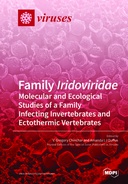Explore

Family Iridoviridae Molecular and Ecological Studies of a Family Infecting Invertebrates and Ectothermic Vertebrates
V. Gregory Chinchar and Amanda LJ Duffus
2019
0 Ungluers have
Faved this Work
Login to Fave
Ranaviruses and other viruses within the family Iridoviridae, infect a wide range of ecologically and commercially important ectothermic vertebrates, i.e., bony fish, amphibians, and reptiles, and invertebrates, including agricultural and medical pests and cultured shrimp and crayfish, and are responsible for considerable morbidity and mortality. Understanding the impact of these various agents on diverse host species requires the combined efforts of ecologists, veterinarians, pathologists, comparative immunologists and molecular virologists. Unfortunately, investigators involved in these studies often work in discipline-specific silos that preclude interaction with others whose insights and approaches are required to comprehensively address problems related to ranavirus/iridovirus disease. Our intent here is to breakdown these silos and provide a forum where diverse researchers with a common interest in ranavirus/iridovirus biology can profitably interact. As a colleague once quipped, “Three people make a genius.” We are hoping to do something along those lines by presenting a collection of research articles dealing with issues of anti-viral immunity, identification of a potentially novel viral genus exemplified by erythrocytic necrosis virus, viral inhibition of innate immunity, identification of novel hosts for lymphocystivirus and invertebrate iridoviruses, and modelling studies of ranavirus transmission. Collectively these and others will exemplify the breadth of ongoing studies focused on this virus family.
This book is included in DOAB.
Why read this book? Have your say.
You must be logged in to comment.
Rights Information
Are you the author or publisher of this work? If so, you can claim it as yours by registering as an Unglue.it rights holder.Downloads
This work has been downloaded 724 times via unglue.it ebook links.
- 663 - pdf (CC BY-NC-ND) at Unglue.it.
Keywords
- amphibian
- Amphibians
- Andrias davidianus ranavirus
- antibody
- antiviral immunity
- aquatic animals
- Artemia spp.
- Bayesian inference
- bearded dragon
- biosecurity
- British Columbia
- co-immunoprecipitation (Co-IP)
- Common frog
- CQIV
- Cricket
- cross-species transmission
- Decapodiridovirus
- disease dynamics
- DIV1
- DNA virus
- early detection
- eDNA
- ELISA
- emerging infection
- endemic disease
- envelope protein
- Epidemiology
- erythrocytic necrosis virus (ENV)
- European chub
- Exopalaemon carinicauda
- frog virus 3
- FV3
- Gryllus bimaculatus
- Heparan sulfate
- histopathology
- host
- Host-Pathogen Interactions
- IIV-6
- Imd
- immunofluorescence
- immunohistochemistry
- immunomodulators
- interferon
- intracellular localization
- Iridoviridae
- iridovirus
- iridovirus core proteins
- ISDL
- lizard
- Lymphocystis disease virus
- Macrobrachium nipponense
- Macrobrachium rosenbergii
- Mathematical models
- megalocytivirus
- Mexico
- n/a
- native-fish conservation
- NF-?B
- nonclassical MHC
- outbreak
- Pacific herring
- Pacific salmon
- Pogona vitticeps
- Prevalence
- Procambarus clarkii
- protein interaction
- Rana grylio virus
- Rana grylio virus (RGV)
- Rana temporaria
- ranavirosis
- ranavirus
- Risk assessment
- SHIV
- Sparus aurata
- susceptibility
- susceptible species
- susceptible-infected (SI) models
- transmission modelling
- Unconventional T cell
- viral erythrocytic necrosis (VEN)
- viral immune evasion
- viral infection
- viral load
- viral transmission
- virus binding
- virus isolation
- virus surveillance
- white head
- yeast two-hybrid (Y2H)
Links
DOI: 10.3390/books978-3-03921-517-1Editions


